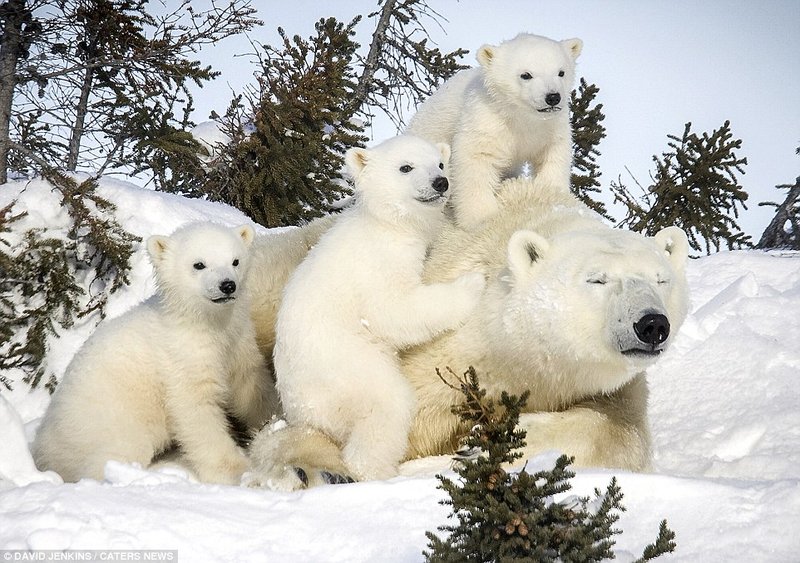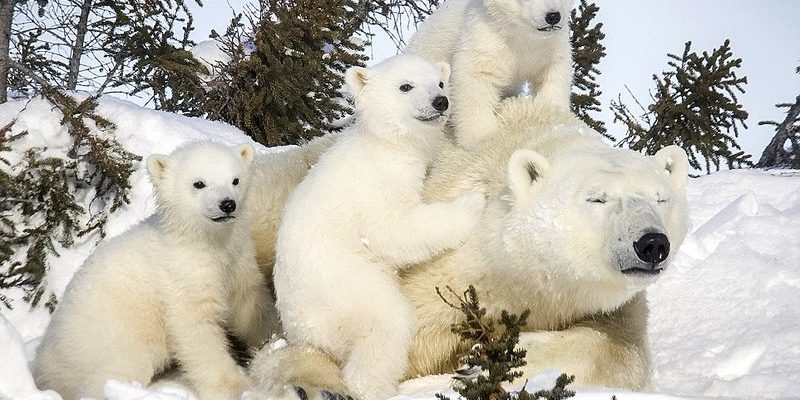
Polar bears often have to be on high alert, from teaching their cubs how to hunt to ensuring they stay warm during the bitter winters. It’s a journey filled with struggles, triumphs, and endless love. If you’re curious about how these magnificent creatures raise their young in the wild, you’re in for an eye-opening experience. Let’s dive into some fascinating aspects of polar bear motherhood!
Gestation and Birth: The Beginning of Life
The gestation period for polar bears is about eight months, a timeframe that might sound short for such large animals. Interestingly, polar bears engage in a fascinating process called delayed implantation. After mating, the fertilized egg doesn’t immediately implant in the mother’s uterus. Instead, it floats around until conditions are ideal, usually in the fall when the mother can build up enough fat reserves to sustain her and her cubs through the winter.
Once winter rolls in, the mother polar bear finds a secluded spot to dig a snow den. Here, she will give birth to typically two cubs, although one or three aren’t out of the question. Can you imagine the excitement? These tiny, helpless creatures are born weighing about a pound and measuring around a foot long. At first, they are blind and covered in fine hair, making them look like tiny white blobs.
The triumph of giving birth is just the beginning. The mother now has to keep her cubs warm, which is no small feat in the freezing Arctic. She uses her body heat and the insulation of the snow den to ensure they stay cozy. It’s a tough job, but for a polar bear, instinct kicks in, and nurturing her young becomes her primary focus.
First Months: Survival and Growth
After about two and a half months in the den, the cubs begin to develop and grow stronger. By this time, they start to gain their sight and can hear as well. The first few months are critical for their survival. During this time, the mother remains in the den, nursing her cubs and keeping them safe from the harsh elements outside.
During this nursing phase, the cubs rely entirely on their mother for food. The mother produces rich milk, which is crucial for the cubs’ growth. This milk is about 31% fat, making it perfect for building up their blubber layer. This is like giving them a warm, protective coat that will help them survive in the icy wilderness later on.
The mother will often lose weight during this nursing period, as she’s using her body fat to feed her growing cubs. You might be wondering how she manages to keep her energy up? Well, before giving birth, she makes sure to bulk up on food, storing as much fat as possible during the summer months. This fat not only nourishes her but also provides warmth during the bitter cold.
Teaching Hunting Skills: A Mother’s Role
Once the cubs are around four months old, they leave the den with their mother, marking an exciting transition. This is when the real adventure begins! The mother bear has the important task of teaching her young how to hunt. It’s like teaching your kids to ride a bike—with plenty of falls and bumps along the way.
Polar bears primarily hunt seals, and this requires a technique called still-hunting. The mother will teach her cubs the importance of patience and stealth. They need to approach the breathing holes in the ice quietly. Imagine balancing on tiptoes on a snowy day—any noise could scare off their prey!
While hunting is essential, it’s just one part of the learning process. The mother also teaches her cubs how to navigate their icy habitat, recognize danger, and understand the importance of conserving energy. You can think of this time as an educational boot camp; the mother plays various roles: teacher, protector, and provider.
Social Bonds: The Importance of Family
Family dynamics among polar bears are incredibly fascinating. Unlike many other species, polar bear mothers and cubs share a strong bond during the first couple of years. The cubs will stay with their mother for about two to three years, learning essential survival skills until they’re ready to venture out on their own.
This extended time together allows the cubs to develop social skills and emotional bonds. They often play and wrestle with each other, which helps them learn about teamwork and building relationships. You might think of it like siblings growing up together—figuring out their roles in a playful yet competitive environment.
At night, when the temperature drops, they’ll snuggle up to stay warm, highlighting the value of warmth—both physically and emotionally. The mother’s nurturing doesn’t just provide food and shelter; it also lays the groundwork for how they interact with others in the wild.
Facing Challenges: The Struggles of Motherhood
Raising polar bear cubs is no walk in the park—even for the toughest mother. One major challenge they face is the changing climate. As ice melts due to global warming, polar bears often have to travel further to find food. Imagine having to hike long distances just to get groceries; it’s exhausting and puts a strain on the whole family.
Additionally, competition for resources can be fierce. Other bears may invade their territory, causing stress for the mother and her cubs. She must constantly be vigilant, ready to protect her young if necessary. This urgency can drain her energy, making it even more critical for her to find food and maintain her strength.
Despite these struggles, mother bears display immense resilience. They adapt to their surroundings, using their knowledge and instincts to ensure their cubs survive. This tenacity highlights the importance of environmental conservation, emphasizing the need for protecting their habitats.
Independence: The Next Chapter
Eventually, the time comes when the cubs must forge their paths. At around two to three years of age, they’ll begin to separate from their mother and become independent. This stage is bittersweet for mothers, who have invested so much in their young ones.
As the cubs leave, they carry with them the survival skills that their mother has instilled. They learn to hunt, avoid danger, and navigate their icy world. This independence is essential for the continuation of their species.
During this transitional period, mothers sometimes have to let go, even as it’s hard to see their young ones go. It’s like sending kids off to college—mixed feelings of pride and sadness. The circle of life continues, and the knowledge passed down from mother to cub reinforces the strength and resilience of polar bears.
Raising young in the wild is an extraordinary journey, especially for polar bears. From gestation to independence, every stage presents unique challenges and lessons. The mother’s role is pivotal not only for the survival of her cubs but also for the future of her species.
Understanding how polar bears raise their young helps us appreciate these magnificent creatures and the delicate balance of their Arctic habitat. We can all play a part in ensuring their survival, whether through advocacy, education, or simply spreading awareness about climate change.
In the end, the story of polar bears and their cubs is one of love, determination, and resilience—a beautiful reminder of nature’s wonders.

